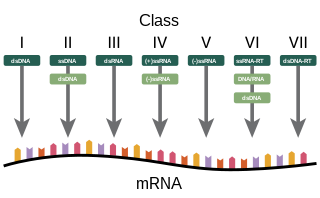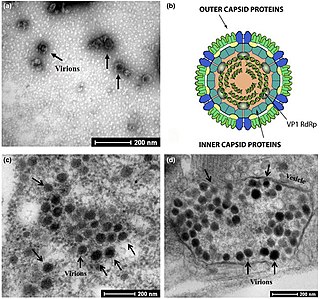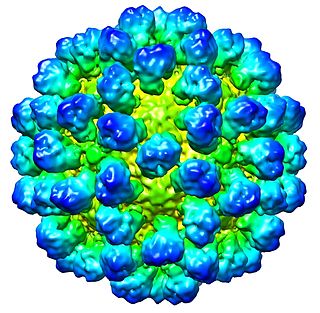
Closteroviridae is a family of viruses. Plants serve as natural hosts. There are four genera and 59 species in this family, seven of which are unassigned to a genus. Diseases associated with this family include: yellowing and necrosis, particularly affecting the phloem.

Tombusviridae is a family of single-stranded positive sense RNA plant viruses. There are three subfamilies, 17 genera, and 95 species in this family. The name is derived from Tomato bushy stunt virus (TBSV).

Tobamovirus is a genus of positive-strand RNA viruses in the family Virgaviridae. Many plants, including tobacco, potato, tomato, and squash, serve as natural hosts. Diseases associated with this genus include: necrotic lesions on leaves. The name Tobamovirus comes from the host and symptoms of the first virus discovered.

Baltimore classification is a system used to classify viruses based on their manner of messenger RNA (mRNA) synthesis. By organizing viruses based on their manner of mRNA production, it is possible to study viruses that behave similarly as a distinct group. Seven Baltimore groups are described that take into consideration whether the viral genome is made of deoxyribonucleic acid (DNA) or ribonucleic acid (RNA), whether the genome is single- or double-stranded, and whether the sense of a single-stranded RNA genome is positive or negative.
Tombusvirus is a genus of viruses, in the family Tombusviridae. Plants serve as natural hosts. There are 17 species in this genus. Symptoms associated with this genus include mosaic. The name of the genus comes from Tomato bushy stunt virus.

Crinivirus, formerly the lettuce infectious yellows virus group, is a genus of viruses, in the family Closteroviridae. They are linear, single-stranded positive sense RNA viruses. There are 14 species in this genus. Diseases associated with this genus include: yellowing and necrosis, particularly affecting the phloem.

Nepovirus is a genus of viruses in the order Picornavirales, in the family Secoviridae, in the subfamily Comovirinae. Plants serve as natural hosts. There are 40 species in this genus. Nepoviruses, unlike the other two genera in the subfamily Comovirinae, are transmitted by nematodes.
Luteovirus is a genus of viruses, in the family Tombusviridae. There are 13 species in this genus. Plants serve as natural hosts. The geographical distribution of Luteoviruses is widespread, with the virus primarily infecting plants via transmission by aphid vectors. The virus only replicates within the host cell and not within the vector. The name 'luteovirus' arises from the Latin luteus, which is translated as 'yellow'. Luteovirus was given this name due to the symptomatic yellowing of the plant that occurs as a result of infection.

Fijivirus is a genus of double-stranded RNA viruses in the family Reoviridae and subfamily Spinareovirinae. Plants serve as natural hosts. Diseases associated with this genus include: galls (tumours) in infected plants and Fiji disease, with severe stunting, deformation and death. The group name derives from Fiji island the place where the first virus was isolated. There are nine species in this genus.

Potexvirus is a genus of pathogenic viruses in the order Tymovirales, in the family Alphaflexiviridae. Plants serve as natural hosts. There are 48 species in this genus, three of which are assigned to a subgenus. Diseases associated with this genus include: mosaic and ringspot symptoms. The genus name comes from POTato virus X).

Carlavirus, formerly known as the "Carnation latent virus group", is a genus of viruses in the order Tymovirales, in the family Betaflexiviridae. Plants serve as natural hosts. There are 53 species in this genus. Diseases associated with this genus include: mosaic and ringspot symptoms.
Vesivirus is a genus of viruses, in the family Caliciviridae. Swine, sea mammals, and felines serve as natural hosts. There are two species in this genus. Diseases associated with this genus include: respiratory disease, Feline calicivirus (FCV); conjunctivitis, and respiratory disease.

Lagovirus is a genus of viruses, in the family Caliciviridae. Lagomorphs serve as natural hosts. There are two species in this genus. Diseases associated with this genus include: necrotizing hepatitis leading to fatal hemorrhages.

Virgaviridae is a family of positive-strand RNA viruses. Plants serve as natural hosts. The name of the family is derived from the Latin word virga (rod), as all viruses in this family are rod-shaped. There are currently 59 species in this family, divided among seven genera.
Macluravirus is a genus of viruses, in the family Potyviridae. Plants serve as natural hosts. There are ten species in this genus.
Fabavirus is a genus of plant viruses in the order Picornavirales, in the family Secoviridae, in the subfamily Comovirinae. Plants serve as natural hosts. There are seven species in this genus.

Comovirus is a genus of viruses in the order Picornavirales, in the family Secoviridae, in the subfamily Comovirinae. Plants serve as natural hosts. There are 15 species in this genus.
Mitovirus is a genus of positive-strand RNA viruses, in the family Mitoviridae. Fungi serve as natural hosts. There are five species in the genus.
Narnavirus is a genus of positive-strand RNA viruses in the family Narnaviridae. Fungi serve as natural hosts. There are two species in this genus. Member viruses have been shown to be required for sexual reproduction of Rhizopus microsporus. Narnaviruses have a naked RNA genome without a virion and derive their name from this feature.
Tritimovirus is a genus of viruses, in the family Potyviridae. Plants serve as natural hosts. There are six species in this genus.









